
Araucaria bidwillii, commonly known as the bunya pine or bunya-bunya and sometimes referred to as the false monkey puzzle tree, is a large evergreen coniferous tree in the plant family Araucariaceae. It is found naturally in south-east Queensland Australia and two small disjunct populations in north eastern Queensland's World Heritage listed Wet Tropics. There are many old planted specimens in New South Wales, and around the Perth, Western Australia metropolitan area. They can grow up to 30–45 m (98–148 ft). The tallest presently living is one in Bunya Mountains National Park, Queensland which was reported by Robert Van Pelt in January 2003 to be 169 feet (51.5 m) in height.
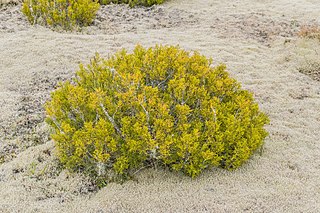
Halocarpus bidwillii, commonly known as the mountain pine or bog pine, is a species of conifer in the family Podocarpaceae. It is endemic to New Zealand.
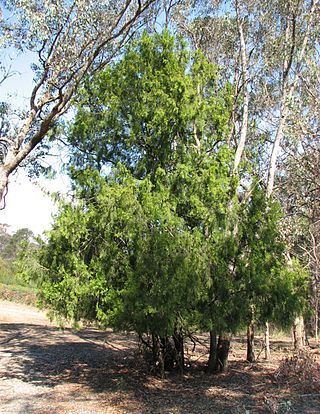
Exocarpos is a genus of flowering shrubs and small trees in the sandalwood family, Santalaceae. They are found throughout Southeast Asia, Australia and the Pacific Islands.

Callitris verrucosa, also known as the Mallee Pine, is a species of conifer in the family Cupressaceae. It is found only in Australia. The tree/shrub has a green/grey colour, rigid branches and can reach a height of 8m. The tree/shrub has a slow grow rate.
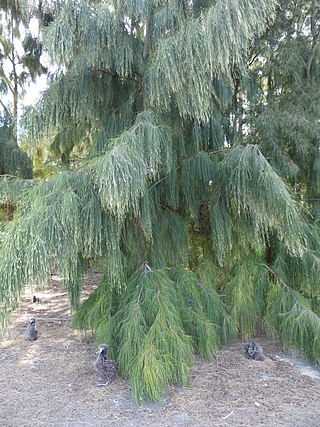
Casuarina glauca, commonly known as the swamp she-oak, swamp oak, grey oak, or river oak, is a species of Casuarina native to the east coast of Australia. It is found from central Queensland south to southern New South Wales. It has become naturalised in the Everglades in Florida where it is considered a weed.

Melicytus dentatus, the tree violet, is a shrub that is native to south-east Australia. It grows up to 4 metres high and has branchlets that are often armed with spines and have leaves that are 5 to 50 mm long and sometimes toothed. The flowers appear in spring and summer and are pale yellow, 3 to 5 mm in length, and have petals that are recurved at the tips. These are followed by pale green to purple-black, rounded berries which are 4 to 5 mm in diameter.

Gossia bidwillii, known as the python tree is a rainforest myrtle of eastern Australia.The usual habitat is the drier rainforest areas. The range of natural distribution is from the Hunter River in New South Wales to Coen in far northern Queensland.
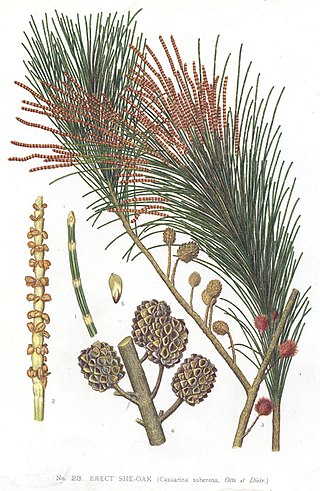
Allocasuarina littoralis, commonly known as black sheoak, black she-oak, or river black-oak, is an endemic medium-sized Australian tree. A. littoralis is named for its growth near the coast; this is somewhat misleading, as it will grow well both inland and in coastal zones. Studies have shown that in long-time unburnt coastal woodlands, A. littoralis has replaced the original Eucalyptus-dominated woodland.

Flindersia australis, commonly known as crow's ash, flindosy or Australian teak, is a species of tree that is endemic to north-eastern Australia. It has pinnate leaves with between five and thirteen egg-shaped to elliptical leaflets, white to cream-coloured flowers arranged in panicles on the ends of branchlets and followed by woody capsules studded with short, rough points and containing winged seeds.
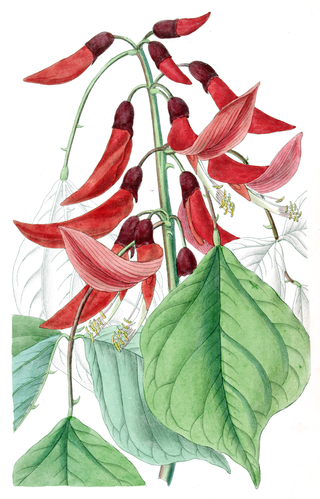
Erythrina × bidwillii is the scientific name for two different cultivars produced from hybridising Erythrina species at Camden Park Estate, New South Wales, Australia, in the early 1840s by William Macarthur, one of the most active and influential horticulturists in Australia.

Eucalyptus albens, known as the white box, is a common tree of the western slopes and plains of New South Wales and adjacent areas in Queensland and Victoria. It has rough, fibrous bark on the base of its trunk and smooth, white bark above. The leaves are lance-shaped and groups of seven spindle-shaped flower buds are arranged in leaf axils or on the ends of the branches. White flowers are mostly present between August and February and the fruit are barrel-shaped to urn-shaped.

Cryptocarya bidwillii, the yellow laurel, is a small to medium-sized tree in the laurel family. Occurring in Australian rainforests from Nymboida in the state of New South Wales to Townsville in tropical Queensland. Often found in the dryer ridges in dry rainforest or in viney scrubs.

Drypetes deplanchei is a tree of eastern and northern Australia. It also occurs in New Caledonia and Lord Howe Island. The genus is derived from the Greek, dryppa meaning "olive fruit". The species named after Dr. Emile Deplanche, who collected this plant at New Caledonia. Common names include yellow tulip, grey boxwood, white myrtle, grey bark and yellow tulipwood.

Planchonella queenslandica, the blush condoo, is a large rainforest tree of the family Sapotaceae native to eastern Australia. It is found in sea side rainforest as well as the drier inland rainforests. From as far south as the Richmond River, New South Wales to Coen in tropical Queensland, and as far west as Melville Island, Northern Territory.
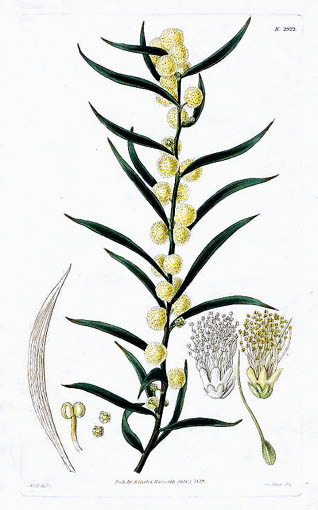
Acacia lanigera, commonly known as woolly wattle or hairy wattle, is a tree species that is endemic south eastern Australia.
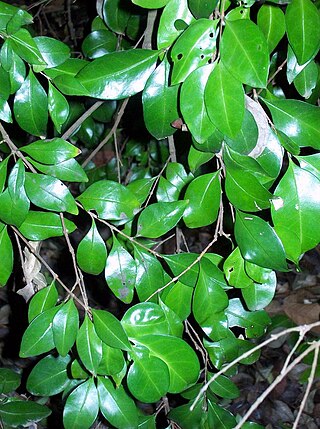
Gossia fragrantissima, the sweet myrtle or small-leaved myrtle, is a shrub or small tree of eastern Australia. A plant with a ROTAP rating of 3EC-, endangered by extinction. Found in sub tropical rainforests near streams, from near Woodburn, New South Wales to Nambour in south eastern Queensland. It features fragrant flowers, hence the specific epithet fragrantissima. White flowers grow from October to February.
Exocarpos homalocladus, commonly known as the grass tree, is a flowering plant in the sandalwood family. The specific epithet comes from the Greek homalos (“flat”) and clados, with reference to the structure of the plant.

Persoonia conjuncta is a species of flowering plant in the family Lamiaceae and is endemic to eastern New South Wales. It is an erect shrub or small tree with narrow elliptic to lance-shaped leaves, yellow, tube-shaped flowers in groups of up to sixteen and green fruit.

Persoonia adenantha is a plant in the family Proteaceae and is endemic to eastern Australia. It is an upright shrub or small tree with smooth, elliptic to lance-shaped leaves and groups of hairy yellow flowers. It has sometimes been confused with P. cornifolia and P. stradbrokensis.

Muellerina bidwillii, common name Cypress-pine mistletoe, is a hemiparasitic arial shrub in the family Loranthaceae. The species is endemic to New South Wales and Queensland.



















